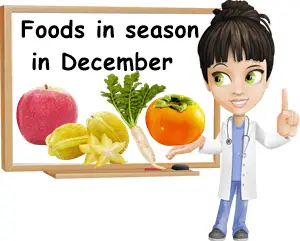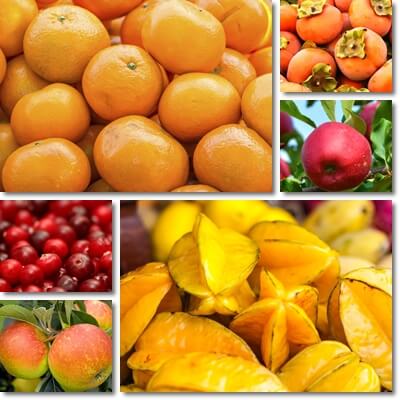What are some of the best foods to eat in December? The month of December is rich in healthy seasonal fruits and vegetables. Several different types of oranges come into season in December, such as mandarins and clementines, but also pomelo, star fruit, sweet persimmon varieties and cranberries, winter apples and authentic winter veggies such as Daikon radishes and black radishes.
Find out what are the benefits of these healthy seasonal December foods to get you excited about eating them.
Mandarin oranges
Mandarin oranges, or mandarins, Citrus reticulata by their scientific name, are in full season November through December. Mandarin oranges are one of the original citrus fruits and came before the common sweet orange. Actually, it was mandarins and pomelos that created the common sweet orange. Mandarins are sweeter and more flavorful than common sweet oranges, and generally lower-acidity which makes them better suited for people with a low tolerance to acidic foods. Mandarins are a good source of vitamin C with over 30% of daily recommended values per 100 g of fruit, and boast anti-inflammatory properties and benefits of collagen synthesis for better skin elasticity and fewer wrinkles.

Clementines
Clementines are also known as clementine oranges and are a mandarin and common sweet orange cross. Clementines are in full season in December, but are available starting November and up until late January. Clementines are extremely easy to peel, making them a great snack for kids, as well as very low-acidity which means they are a good option for those with acid reflux disease, if consumed in moderation. Clementines are even more nutritious than mandarins, with almost double the vitamin C content and good amounts of vitamins B1, B6, B9 and potassium. The seasonal winter fruit has anti-inflammatory properties and is good for gums and teeth and blood pressure.
See more types of oranges.
Pomelo
Pomelos (Citrus maxima, Citrus grandis) are the ancestors of the common sweet orange and a fruit in season in December. Pomelos are great to eat because they are neither bitter like grapefruits, nor acidic like oranges. You can choose pomelos over oranges if you have acid reflux disease (GERD) and can’t have acidic fruits. Pomelos are also higher in vitamin C than most oranges at over 70% of daily values per 100 g. Vitamin C boasts anti-inflammatory and anti-aging benefits, actively lowering levels of inflammation markers such as C-reactive protein and boosting production of collagen for better skin elasticity. Pomelos are also good for high blood pressure and low-fat and low-calorie.
Star fruit
In season in December, star fruit (Averrhoa carambola) is a tropical fruit whose cross section looks like a star, hence the name. Sweet varieties of star fruit are a generous source of vitamin C with anti-inflammatory and antioxidant benefits, and contain good amounts of vitamin B5 to combat tiredness and fatigue, low mood and sleep problems. However, star fruits are best not eaten by anyone with kidney problems due to having a high content of oxalic acid, and are known to interact with certain medication, potentiating their effects. This warrants caution with regards to intake, frequency of consumption, not to mention the fruit requires being well spaced apart from any medication.

Sweet persimmon (kaki)
Varieties of sweet persimmon (Diospyros kaki) are still in season in December and a great fruit to consider for this time of the year, either as it is or used in baked goods such as traditional Christmas persimmon pudding. Sweet persimmons, while not very complex flavor-wise, have a pleasant, mellow sweet taste and soft, moist flesh. The dark red-orange tomato-like seasonal fruit is high in beta-carotene, a pro-vitamin A antioxidant with benefits for color vision and visual acuity. Persimmon fruits are also source of pigmented lutein and zeaxanthin antioxidants which, studies show, can help reduce risks of age related macular degeneration (AMD) and even cataract.
Cranberries
Cranberries are one of the best December foods to eat. The bright red, astringent fruit are harvested in North America starting mid-September, with harvesting continuing up until mid-November. Which means cranberries are in season for the holidays, from Thanksgiving to Christmas. Cranberries get their color from special pigmented anthocyanin antioxidants called proanthocyanidins with benefits of urinary tract infections.
Drinking cranberry juice can help reduce the frequency, severity and duration of UTIs as well as provide important antioxidant benefits. The seasonal December fruit is a good source of vitamins C and E with benefits for skin.
Daikon radishes
Daikon radishes (Raphanus sativus longipinnatus) are a variety of winter radish with white skin and flesh. While available at different times during the year, November-December is a great season for the Daikon radish since the cold weather makes it taste better. In addition to a spectacular root vegetable to compliment your winter decor, the Daikon radish is a good source of vitamin C for healthy teeth and gums. The winter vegetables boasts anti-inflammatory properties and helps boost collagen production for better skin elasticity, if eaten raw.
Cooked Daikon radish is still healthy: it has potassium which is good for high blood pressure and vitamin B9 which helps prevent defects of the brain, spine and spinal cord in babies during pregnancy. You can also pickle Daikon radishes for a unique prebiotic and probiotic food to boost good gut flora populations.
Black radishes
Black radishes (Raphanus sativus niger) are a variety of winter radish with dull brown-black or jet black skin and glossy white flesh. While not particularly flavorful, black radishes are a great source of therapeutic benefits and one of the best vegetables in season in December. Black radishes help prevent cholesterol gallstones by lowering blood cholesterol and hepatic cholesterol levels, as well as exert a hepatoprotective action, limiting and actively combatting liver damage.
See more benefits of black radishes.
December apples
Did you know that apples are still in season in December? Late-season apples, also known as winter apples, account for a significant percentage of all apple varieties and include varieties of apples that are harvested mid-late fall to early winter and any late-season apple that stores really well. Ashmead’s Kernel, Baldwin, Black Twig and Braeburn apples, Idared, Melrose and Mutsu apples, Pink Lady, Rome apples, Staymans apples and more varieties are available all of December and, if kept well, can last until February or April. Seasonal winter apples bring freshness to the table and make healthy, low-calorie, low-fat snacks, good to eat for nausea, weight loss and weight management and for healthy gums.
